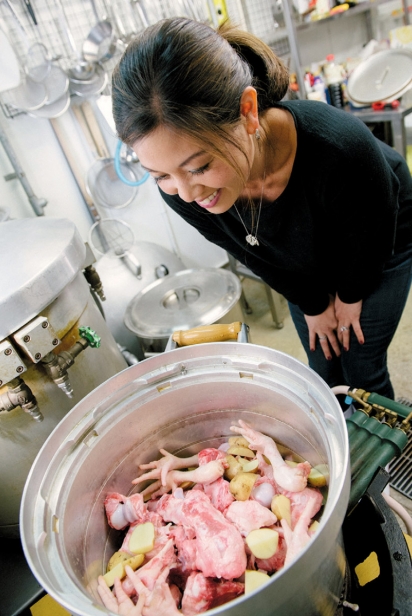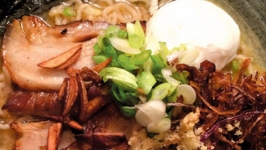Preserving Family History through Food
BODY- AND SOUL-WARMING CONNECTIONS
In May 1942, when Yvonne Fujimoto was 3 years old, she and her family were given 10 days to pack only what they could carry, store the rest of their belongings and move to the Amache Japanese Relocation Camp in Granada, Colorado. Accused of being potential spies for Japan, the Fujimotos were forced to relocate to the internment camp by order of President Franklin D. Roosevelt.
Yvonne was born in the United States. San Francisco, to be exact. Both of her parents were also born in Northern California. None of that mattered. Just two months after the Japanese bombing of Pearl Harbor, all people of Japanese ancestry in the United States—whether 100% or 1/16—were forced into internment camps. Two-thirds of the more than 120,000 who were interned were American citizens, just like Yvonne, my mother.
My father, who grew up in East Los Angeles, was also interned with his family at the Heart Mountain Japanese Relocation Camp in Wyoming.
In 1988, after years of advocacy by the Japanese American community, President Ronald Reagan signed into law the Civil Liberties Act of 1988 (the “Act”) that granted reparations to Japanese Americans who had been interned in the camps. The legislation stated that the government’s actions were based on “race prejudice, war hysteria, and a failure of political leadership,” as opposed to legitimate security reasons. A total of 82,219 people received redress checks of around $20,000 each. My grandparents were the last generation to receive this reparation before the fund ran out of money.
Notably, the Act was co-sponsored by California’s Democratic Congressman Norman Mineta, an internee as a child, and Wyoming’s Republican Senator Alan Simpson, who first met Mineta when he visited an internment camp. The third co-sponsor of the legislation was California’s Republican Senator Pete Wilson.
Even though internment and the years of shame and humiliation that followed are very much a part of my family’s history—and U.S. history—we rarely talked about it. Whether you are first- or fourth-generation Japanese, the “Japanese way” is to keep quiet about these things, be grateful, work hard and move on.
Then last year, my daughter’s fifth grade class at Old Mill Elementary School in Mill Valley studied about the internment of the Japanese during the war. On Open House night, I was stunned to see essays on the subject covering the classroom walls. When I was in school, it was a quick blurb in history books, glossed over by my teacher, and something I was embarrassed to talk about. I had identified more as American than Japanese, and I feared my friends might think differently of me if my family’s history was “discovered.” When I asked, my daughter’s teacher told me that Japanese internment still isn’t part of any mandatory curriculum, but, rather, it was her personal choice to delve deeper into this important piece of history.
My mother remembers the years immediately after her family was released from Amache. People would throw rocks at her and her sisters and call them “Japs”—an ethnic slur after the war. Money was tight. My grandmother went to work as a seamstress and my grandfather eventually went to work for the same Japanese import/export business he had worked with before the war. They grew vegetables in their garden. My mother and her sisters learned how to cook and stretch their food out for days. Fried rice, considered a Japanese peasant dish made from leftovers, was a family staple.
When my mother attended the University of Southern California, where she studied to become a dental hygienist, she was excluded from joining a sorority because of her ethnicity. After college, she and her other Japanese American friends formed their own group they called “The Dames”—the Martha Stewarts of their time. They would host fabulous dinner parties, bringing together delicious dishes of both Japanese and American origins. The Dames eventually created a cookbook that is now sold at the Japanese American National Museum in Los Angeles.
The Dames and their husbands would gather to eat and talk for hours, dressed to the nines, tables set with their best silver and crystal. The Dames’ kids were a part of it all, of course, and this is where my love of cooking and appreciation of sharing good food began. I used to make mud pies in the backyard and pretend I had my own cooking show from the age of 5.
I am what is known in the Japanese community as a “Yonsei,” a fourth-generation Japanese American. It would be easy to think my Japanese roots are diluted—I do not speak Japanese fluently and I am much louder and more opinionated than the stereotype of Japanese women. But for me, the “Japanese way” is something that persists without regard to time and distance from the homeland.
At a young age, my mother taught me that you “eat with your eyes” first. In our culture, food presentation is just as important as the preparation. I learned to make dishes that were colorful and pleasing to the eye. Sometimes, the finishing touch was garnishing a dish with a sprig of Heavenly Bamboo from the garden. I still believe that the right pop of color on the plate makes all the difference.
For my first cookbook, Simply Ramen, I started idea gathering with The Dames’ cookbook: rich with the memories of all of those great parties that my parents would throw and every recipe was easy to follow. My research then moved to the best ramen shops in Northern California and, eventually, to Tokyo, where I attended ramen cooking school and learned how to tailor my recipes for the home cook. I know now the difference between a good bowl of ramen and a great one.
What’s makes a great bowl of ramen? The perfect density of soup brimming with depth and layered flavor; salt content that’s not overpowering; handmade noodles that are firm yet springy and hold up to the soup; and fresh toppings that have each been given as much attention as every other component. A great bowl will satisfy your body and give comfort to your soul hours after you’ve eaten, and is best enjoyed with friends and family.
I believe that a well-made ramen embodies the richness of my heritage and honors my ancestry. I hope you enjoy this part of me.






